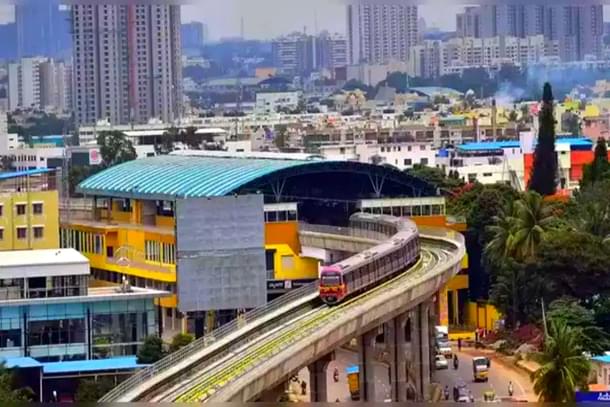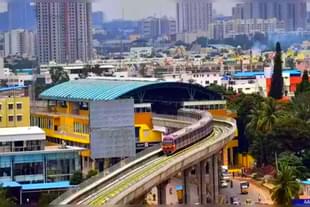Infrastructure
Despite Metro Expansion, Long Commutes And Traffic Congestion Plague Bengaluru’s Workforce: Report
V Bhagya Subhashini
Sep 18, 2024, 06:47 PM | Updated Sep 19, 2024, 10:40 AM IST
Save & read from anywhere!
Bookmark stories for easy access on any device or the Swarajya app.


Bengaluru's rapid urban expansion and booming job market are putting immense pressure on its public transportation system, exacerbating the city’s notorious traffic congestion and negatively affecting workforce productivity, livability, and competitiveness.
According to a new working paper released by nonprofit WRI India, despite the expansion of Namma Metro with Phases 2, 2A, and 2B, only 28 per cent of Bengaluru's formal-sector jobs will be located within 500 metres of the nearest metro station — a benchmark distance for comfortable walking.
While 59 per cent of jobs will be within a kilometre, and 85 per cent within 2 km, the paper highlights that Bengaluru still lags behind global cities in this regard. The Namma Metro network is set to grow to 175.55 km upon completion of the new phases by June 2026, yet challenges remain in connecting job hubs to public transit.
The report, titled "Jobs near metro rail transit in Bengaluru: Enabling an accessible and productive city", emphasises that a global city like Bengaluru should aim to meet international standards. Hong Kong, for example, has 57 per cent of its formal jobs within 500 metres of a transit station, a stark contrast to Bengaluru's projection.
Transit-Oriented Development And Bengaluru's Growth
Authored by Radha Chanchani, Amartya Deb, Jaya Dhindaw, Jyoti, and Madhav Pai, the report outlines the need for Bengaluru to adopt a comprehensive transit-oriented development (TOD) strategy to bridge the gap between urban expansion, public transport, and employment centres. Released on 11 September, the paper examines how TOD could enhance public transport accessibility and boost workforce productivity in the city.
In line with this, Karnataka approved the TOD Policy (TODP) in 2022. The policy aims to encourage high-density, compact development near transit stations and promote walking, cycling, and the use of public transport. This policy aligns with Bengaluru's Comprehensive Mobility Plan, which seeks to increase the share of motorised public transport from 48 per cent in 2015 to 70 per cent by 2031.
Disconnected Job Hubs And Longer Commutes
The WRI study used January 2023 data from the Labour Department, focusing on registered factories, shops, and commercial establishments. It assessed the proximity of jobs to operational and under-construction metro stations across Bengaluru. The study found that Bengaluru Urban houses nearly two lakh registered enterprises, employing around 4.8 million workers — 95 per cent of whom are within the Bengaluru Metropolitan Area.
However, the paper reveals that large employment hubs, located on the city's outskirts, remain disconnected from the metro network, creating a major barrier to accessibility. Most jobs in these areas fall outside the comfortable 500-metre walking distance from metro stations, leading to increased reliance on private vehicles and worsening traffic congestion.
"Traffic congestion is the number one complaint from people working in Bengaluru," said Jaya Dhindaw, one of the report’s authors, in a statement to Deccan Herald. "If Bengaluru aspires to be a global city, it must set ambitious goals for relocating jobs near transit stations. This will not happen overnight. There must also be safe and secure sidewalks so that people are willing to walk 500 metres to a kilometre."
Recommendations For The Way Forward
The WRI paper makes several recommendations, including incentivising businesses to relocate near metro stations by offering location-efficient policies and upgrading public infrastructure. The report suggests that job density should be prioritised in the city’s TOD planning and calls for the government to expedite the preparation of the Revised Master Plan 2041.
Additionally, the authors highlight the need to focus development within the city core while discouraging sprawl on the periphery. This approach could reduce traffic congestion, cut commuting times, and improve overall quality of life for the city's workforce.
WRI India plans to engage with Namma Metro and other government agencies through a series of discussions to explore how to implement these recommendations effectively. The goal is to align Bengaluru’s growth trajectory with its ambition of becoming a more accessible, sustainable, and globally competitive city.
As Phases 2, 2A, and 2B near completion, the report serves as a crucial call to action for the city's policymakers and planners, urging them to rethink urban growth strategies and make public transport central to Bengaluru’s future.
V Bhagya Subhashini is a staff writer at Swarajya. She tracks infrastructure developments.





